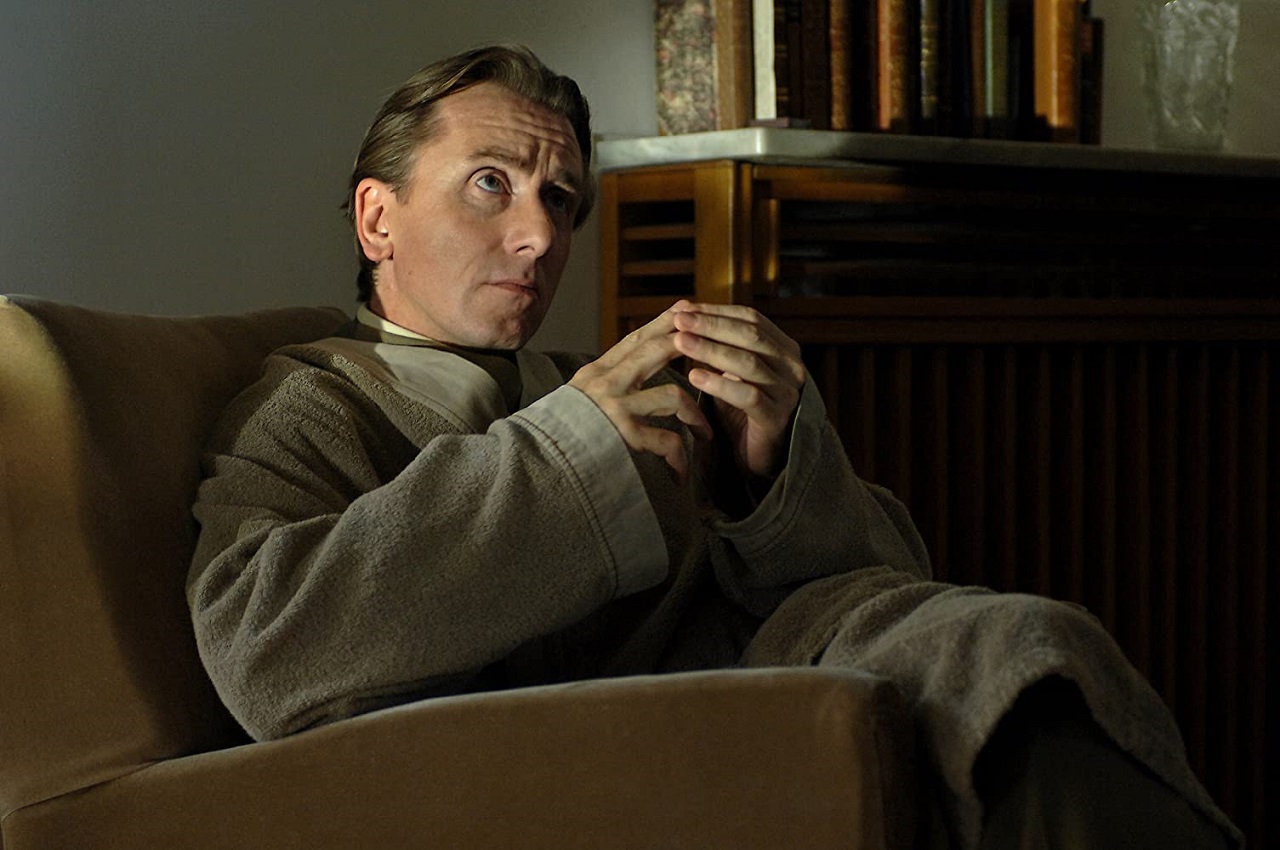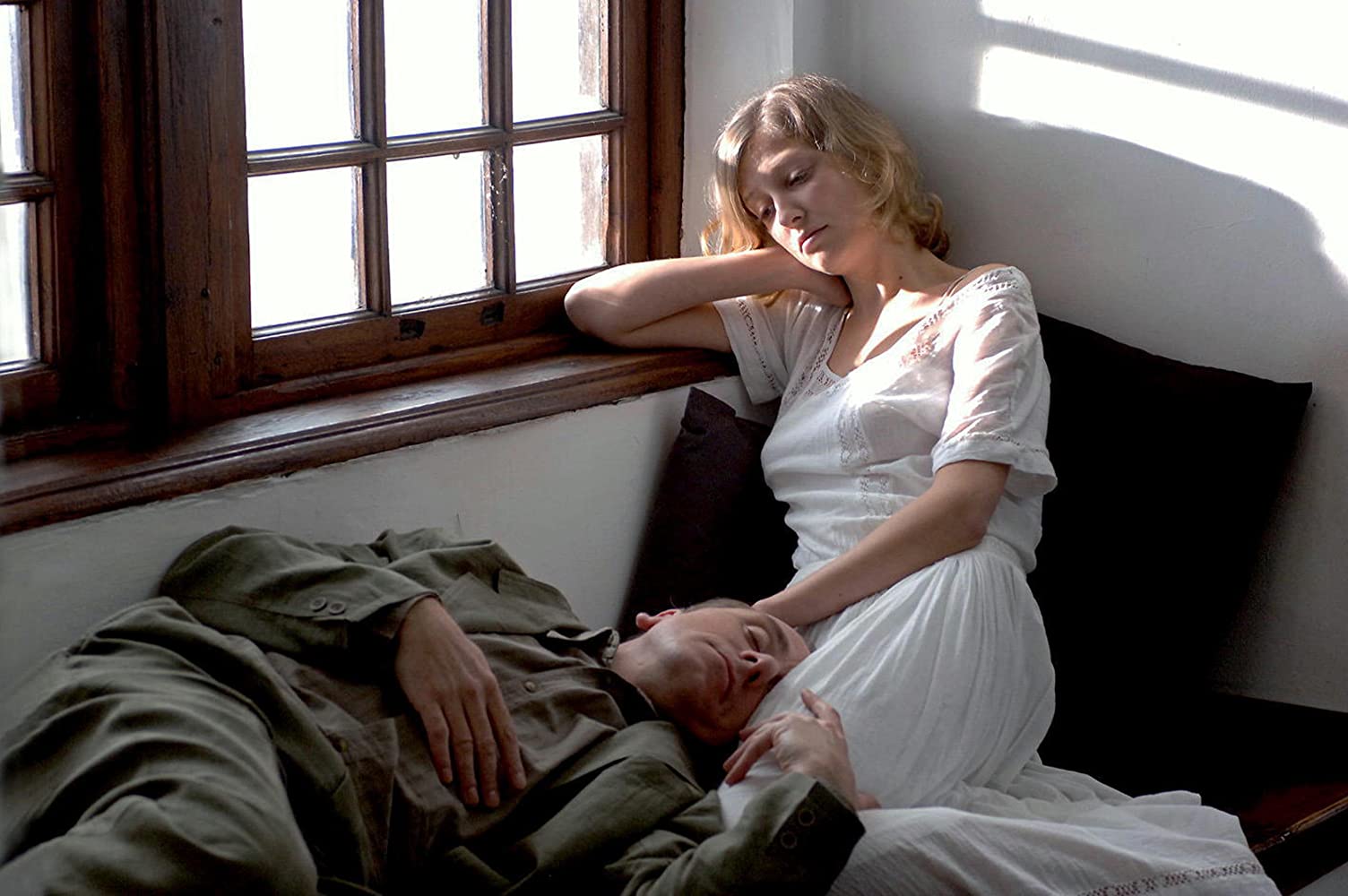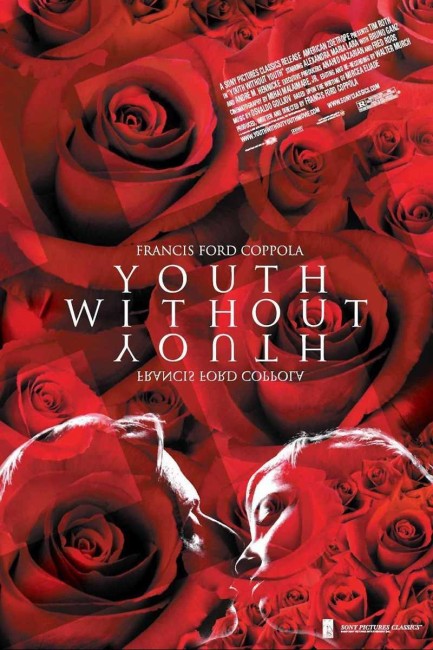USA/Germany/France/Italy/Romania. 2007.
Crew
Director/Screenplay/Producer – Francis Ford Coppola, Based on the Short Story by Mircea Eliade, Photography – Mihai Malaimare Jr, Music – Osvaldo Golijov, Visual Effects Supervisor – David Vana, Makeup Design – Peter Swords King & Jeremy Woodhead, Production Design – Calin Papura. Production Company – American Zoetrope/SRG Atelier/Pricel/BIM Distribuzione.
Cast
Tim Roth (Dominic Matei), Alexandra Maria Lara (Veronica/Laura/Rupini), Bruno Ganz (Professor Stanciulescu), Marcel Iures (Professor Giuseppe Tucci), Andre M. Hennicke (Dr Josef Rudolph), Alexandra Pirici (Woman in Room 6), [uncredited] Matt Damon (Ted Jones)
Plot
Bucharest, 1938. Dominic Matei, a professor of Oriental languages who is in his seventies, is suddenly struck by a bolt of lightning in the middle of the street. He survives, badly burned. Professor Stanciulescu tends him in the hospital but realises that the lightning has somehow regenerated Dominc’s body and that he is now physically a man in his thirties. As Dominic recovers, he discovers that along with his regenerated youth, he has remarkable new intellectual capacity, including that of simply ‘knowing’ a book simply by touching it. His miraculous recovery also attracts the attention of the Nazis. Stanciulescu is successful in helping Dominic create a fake identity to smuggle across the border into Switzerland. Even there, Dominic must stay on the constant run from Nazis and other governments who seek to find and exploit him. In the 1950s, while hiking in the Alps, Dominic meets a young tourist Veronica and is instrumental in organising a search when she goes missing. He finds her in a cave in a fugue state talking Sanskrit. Dominic brings a group of academic specialists in to examine her. The spirit Rupini that speaks through Veronica guides them to India to find a hidden holy manuscript. A romance grows between Dominic and Veronica. However, as they go away together, the spirit of Rupini takes over Veronica and guides her back through a history of ancient languages. As this seems to head towards the culmination of Dominic’s life’s work, he realises that the process is also exhausting and killing Veronica.
Francis Ford Coppola is one of the great American directors. This is the man behind undisputed classics like The Godfather (1972), The Conversation (1974), The Godfather Part II (1974) and Apocalypse Now (1979). Equally, Coppola’s genius has been wildly uneven, he having embarked on enormous spendthrift risks that caused films to frequently go over-budget, resulting in massive flops like One from the Heart (1981) and The Cotton Club (1984) and his American Zoetrope production company to collapse into bankruptcy. Into the late 1980s and 90s, Coppola was working as a director for hire, taking up commercial projects like Peggy Sue Got Married (1986), Bram Stoker’s Dracula (1992), Jack (1996) and The Rainmaker (1997). Coppola had always had a dream of creating his own studio that was driven by artistry and away from interference by the commercial mainstream but the stress of both doing so and the process of working for studios eventually caused Coppola to withdraw into a dissatisfied retirement. Youth Without Youth was Coppola’s first film in a decade and he has since concentrated on making small, independent films.
There are a considerable number of similarities between Youth Without Youth and the more high-profile The Curious Case of Benjamin Button (2008), which was released fourteen months later. In both films, the protagonist of the show finds that they have miraculous (and never-explained) properties of youth – Tim Roth regenerating and never aging here; Brad Pitt aging in reverse in Benjamin Button. Maybe you describe Youth Without Youth as a conceptual crosshatch between Benjamin Button and Phenomenon (1996), which had John Travolta hit by a lightning bolt and suddenly gaining vast mental powers and insight into the meaning of life. There are even more similarities to the subsequent mainstream romantic film The Age of Adaline (2015), which had Blake Lively rendered unaging after being frozen and then struck by lightning.
I was heavily disappointed with Youth Without Youth – this is a film from Francis Ford Coppola, one of the American greats, we are talking about. It has the feel of a European art film – not too surprising in that it was principally funded in Europe and shot in Romania with a largely Romanian cast. There are some beautiful and exquisitely shot scenes, as might be expected from Coppola. However, it also has the feel of a pretension-filled student film that strains with the effort of trying to be profound.

There is much about the study of obscure languages and philosophy and talk about Tim Roth’s professor making mystic breakthroughs in understanding – but none of this understanding is communicated to the audience. If a film deals with the meaning of life, then it needs to communicate some sense of conceptual breakthrough and understanding to an audience. As it is, the profundities look like no more than someone who casually litters books by name philosophers on their coffee table for visitors to see without ever having read any of them.
The other big disappointment is that the film is so scattershot story wise. Unlike Benjamin Button, Francis Ford Coppola seems to lack any interest in exploring the hero’s condition or his unique perspective on 20th Century history. There is some time spent on these near the start but about the point that the Nazis enter the equation and Tim Roth becomes a fugitive, all interest either in Roth’s condition or the historical period disappears. (Moreover, this is about the point that Youth Without Youth goes from a story that seems to be going somewhere to collapsing into a pretentious muddle).
Unlike Benjamin Button, which became a transformational part that earned Brad Pitt an Academy Award nomination, Tim Roth seems buried under the role. This is a character-acting role, one where an actor could have a field day in playing between the extremes of age. Tim Roth is an actor who is alternately far too perky or else has a history of devious weasel roles and simply is not right for the part. On screen, he seems to disappear inside the story and never shines as one expected that he would have. The age makeup here is also decidedly inferior to the work we saw in Benjamin Button.

Perhaps the most harebrained part of the film is the Rubini subplot where the lovely Alexandra Maria Lara appears to become possessed and starts chanting ancient languages as she is drawn mentally back in time. Even writing a synopsis of such makes it sound incredibly silly – and the filmed version is no better. It is also a subplot that wrenches Youth Without Youth away from itself and takes it into the arena of what could be almost described an academic horror film – but the straight-faced presentation of the idea propels it and most of the film into the pretentiously absurd. There is no explanation of why these things are happening – why Alexandra Maria Lara is being possessed, what force is behind it, why it is trying to demonstrate this to Tim Roth and why only his presence seems to be triggering this effect.
This is just one of a bunch of muddled and random story aspects. There appears to be a double of Tim Roth that occasionally turns up throughout, although we are never sure if this is a narrative device – a means to show internal dialogue by Roth having conversations with other parts of himself, or whether the double has some ontological existence as his ability to cause roses to appear or be visible to Alexandra Maria Lara would suggest. Whatever the case, the effect puzzles more than it clarifies anything that is happening.
The film reaches a baffling end where Tim Roth returns to his favourite bar, meets his old friends, tries to explain the 20th Century to them where we are suddenly not sure if everything that has happened is a dream, before Roth is then found dead at the bottom of a series of steps with a rose in his hand. It is a baffling ending and moreover one that seems to mitigate much of what has happened. Unfortunately for Francis Ford Coppola, it makes for a film that is muddled and swamped by its pretensions.
Francis Ford Coppola’s other films of genre interest are:– the re-edited Russian sf film Battle Beyond the Sun (1963); the psycho-thriller Dementia 13/The Haunted and the Hunted (1963); the leprechaun musical Finian’s Rainbow (1968); the time travel fantasy Peggy Sue Got Married (1986); Bram Stoker’s Dracula (1992); the ghost story/vampire film Twixt (2011); and the epic SF film Megalopolis (2024). Coppola has also produced work within the genre from George Lucas’s debut feature THX 1138 (1971), the alien visitor tv movie The People (1972), the ghost story Haunted (1995), the tv mini-series White Dwarf (1995) set on an alien world, Andrei Konchalovski’s epic mini-series version of The Odyssey (1997), the X Files ripoff tv series First Wave (1998), the Hawaiian supernatural revenge film Lanai-Loa: The Resurrection (1998), Agnieszka Holland’s Catholicism and miracles drama The Third Miracle (1999), Victor Salva’s Jeepers Creepers (2001) and Jeepers Creepers II (2003), and the eccentric Hal Hartley monster movie No Such Thing (2001).
Trailer here


